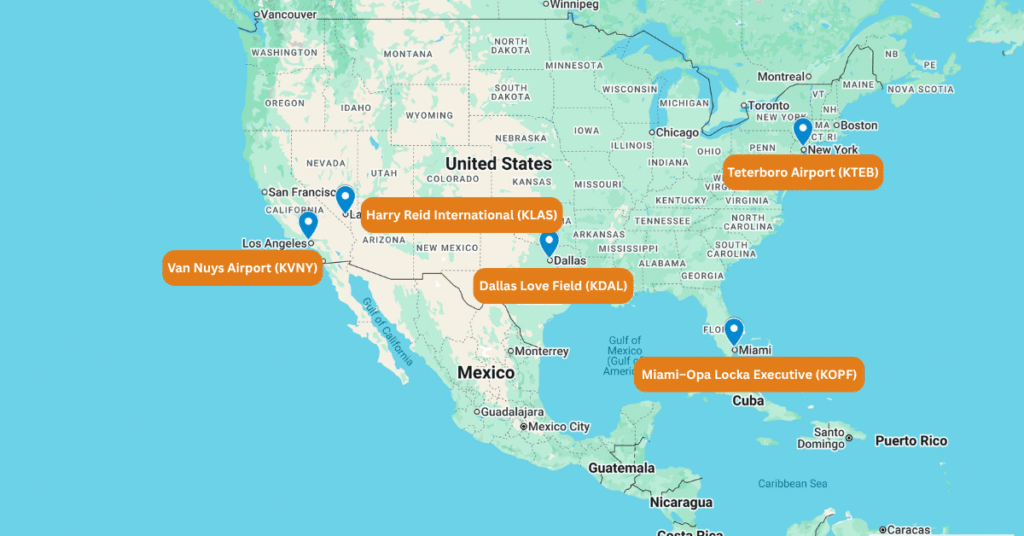Although most U.S. airports are standardized in terms of operating procedures, factors such as hangar and fuel availability, and customs operating hours can change quickly, particularly in heavy-volume business-aviation airports. As such, pilots and flight planners must be current with this information to ensure that flight planning proceeds efficiently.
Below we evaluate the current operating environment that exists at five of the busiest general aviation airports in the U.S. These airports include Teterboro Airport (KTEB) in New Jersey; Van Nuys (KVNY) in California; Miami-Opa Locka Executive (KOPF); Dallas Love Field (KDAL), and Harry Reid International (KLAS), in Nevada. Each airport offers a distinct environment that varies according to geographical location.

KTEB – Teterboro Airport (NJ)
Teterboro Airport has always been one of the most sought-after entry and exit airports within corporate aviation in the Northeast, located just over the Hudson River from Manhattan. The airport operates 24/7 with customs clearance.
Operational Snapshot:
- Airport Restrictions: None
- Operating Hours: 24/7 (airport and CIQ)
- PPR/SLOT Requirements: Not applicable
- Fuel Status: Normal – no shortages
- Parking/Hangar Space: Not guaranteed during weeklong stays
- Permit Lead Times: N/A
As Teterboro does not have strict slot requirements or PPRs, parking capacity is still the airport’s biggest problem. During peak activity such as the United Nations General Assembly Meeting and New Year’s celebration, ramp delays can be substantial. Crews are encouraged to communicate with their trip support partner as soon as possible and to use nearby alternates such as HPN (White Plains) or MMU (Morristown) if overnight parking is unavailable.
KVNY – Van Nuys Airport (CA)
Van Nuys is the beating heart of the U.S. West Coast’s General Aviation Community. Situated in Los Angeles’ San Fernando Valley, it accommodates everything from light jets to ultra-long-range aircraft, supported by several full-service FBOs.
Operational Snapshot:
- Airport Restrictions: None
- Operating Hours: 24/7
- PPR/Slot Requirements:
- Fuel Status: Normal – no shortages
- Parking/Hangar: Available with a duration of seven days
- Permit Lead Times: N/A
The round-the-clock availability of Van Nuys Airport makes it an essential hub for domestic and overseas missions. It has excellent maintenance facilities and hangar space that facilitate activities such as plane repositioning missions. The airport has tight coordination that ensures there are no delays to crews’ activities despite the large flow of operations.
KOPF – Miami-Opa Locka Executive (FL)
For those operators flying to South Florida, Opa Locka Airport provides direct access to downtown Miami and the beaches that attract high net-worth visitors.
Operational Snapshot:
- Airport Restrictions: Not for Part 91 operations
- Operational Hours:
• Airport – 24/7
• CIQ – 0900 to 2359 Local (extended hours can be arranged in advance with CBP) - PPR/SLOT Requirements: None at present; potentially altered during Art Basel Week (December 4–8)
- Fuel Status: Operating normally with no shortages
- Parking/Hangar: Ramp parking – Global 6000: USD 1,404. Hangar unavailable at the moment
- Permit Lead Times: Not applicable to Part 91 U.S. operations
Opa Locka is particularly vulnerable to event-related traffic. Events such as Art Basel Miami, Miami Boat Show, and sports activities might pose temporal constraints to capacity. It is essential that pilots obtain ramp-time reservations in advance and stay in close contact with the trip support service provider to get customs extensions and overtime authorization.
You might also like: New U.S. Entry Rules: What Private Jet Pilots and Operators Should Know
KDAL – Dallas Love Field (Texas)
Strategically positioned only minutes from downtown Dallas, Love Field has expanded to become an ideal location for full-scale business aviation operations with 24-hour services designed to serve Part 91 and Part 135 operations.
Operational Snapshot:
- Airport Restrictions: None
- Operating Hours: 24/7 (airport and CIQ)
- PPR/Slot Requirements: None
- Fuel Status: There are no shortages
- Parking/Hangar: First come, first served. Trip support provider can coordinate
- Permit Lead Times: Trip support provider should coordinate with customs to verify
Because of its prime location, KDAL is an ideal stopover point for cross-country operations. Although hangar space exists, this varies depending on the presence of permanent tenants and corporate operators. Advanced planning and periodic communication with the FBO ensure that preferred parking can be maintained.
KLAS – Harry Reid International (Nevada)
Las Vegas remains an attractive destination for business aviation activities, particularly in conjunction with trade shows and sports activities. Harry Reid International Airport is an always-open airport that caters to commercial and general aviation with FBO areas set aside for private aviation operations.
Operational Snapshot:
- Airport Restrictions: None
- Operational Hours: 24/7 (airport); CIQ – to be contacted for operational hours
- PPR/Slot Requirements:
- Fuel Status: Normal – no shortages
- Parking/Hangar: First come, first served; confirmation on arrival only
- Permit Lead Times: N/A
As there are continuous activities in Las Vegas such as CES (tech event), F1 racing, and sports championships that take place throughout the year, one should note that there will be no ramp capacity during these times. FBO activity is also to be anticipated.
Operational insights and takeaways

24/7 Access:
It was standard that all airports had round-the-clock operations to facilitate flexibility in flight schedules.
Fuel Stability:
At present, no shortages are anticipated; however, that may change without warning, something to keep in mind during peak traffic times.
Parking Pressure:
Demand remains the most significant operational uncertainty, especially with regards to KTEB and KLAS airports that tend to fill quickly.
Event Impact:
Temporary restrictions occur from time to time in KOPF and KLAS during big events such as Art Basel and conferences.
Communication:
Direct communication with customs and handlers is essential to ensure smooth clearance and handling.
As pilots embark from these airports, experienced trip support companies are essential in making these processes seamless. From slot requests to handling flight crews and arranging CIQ, real-time assistance ensures that there are no delays after arrival.
Finally, predictability begins with planning. Airports’ status reports and collaboration with seasoned companies such as Icarus Jet enable flight crews to steer clear of possible difficulties that come with heavily congested airports. In an environment whereby every minute matters to get one’s mission accomplished on time, there are essential keys that must precede flight.
FAQs
1. Do the top executive airports in the U.S. require Prior Permission (PPR) or slot coordination?
The Harry Reid International (KLAS) airport is the only one that requires PPR; the others are slot- and PPR-free. This may change with special traffic events such as the Art Basel event in Miami.
2. Do these airports experience fuel shortages or any anticipated fuel delays?
Regarding fuel shortages, there are no shortages as of current reporting. But fuel supply may change depending on supply chain and seasonal factors. Please check with your FBO/trip support 24 hours ahead of flight time.
3. How reliable is parking availability during extended stays?
Parking and hangar capacity are highly variable. At KTEB and KLAS first come, first served with no guarantee; with reservation, stays are possible during seven days at KVNY and KDAL; and KOPF has ramp but no hangar capacity.
4. When are Customs and Immigration services available at KOPF (Miami-Opa Locka)?
CBP is operational from 0900 to 2359 local time; extended hours are possible with prior notice through your trip support provider or FBO.
5. Do Part 91 flights need permits in the United States?
Not Applicable. Operating Part 91 with N-registered aircraft does not need operational permits. The lead times to obtain permits are required only if it involves international arrival/departure operations.




